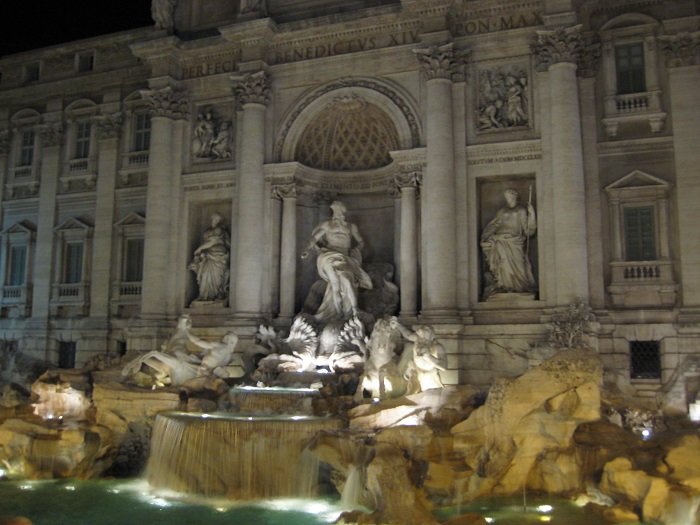
Join Thor and me as your Italy virtual vacation continues with walks taking us to some of the famous fountains of Rome.
NOTE: Since travel is still on hold with the pandemic continuing, I’ve started a new blog series offering a virtual vacation and time-travel to my first big trip with Thor in 2008. Italy! Starting with highlight photos posted here on Saturday, Jan. 30, I’ll continue every week. Join us in Rome, Florence, Cinque Terre, Venice, and Milan. Buon viaggio!
Rome is a vibrant, bustling city seemingly made for rambling on foot (with assist from the underground). This week we’ll take you on bits of our walks around the central areas, focusing on some of the justifiably famous fountains.
The streets were especially appealing at night, when it seemed everyone was out enjoying the somewhat cooler air (we were visiting during a September heat wave) and the energy of nightlife. The first evening out, we started at the also-famous Spanish Steps:
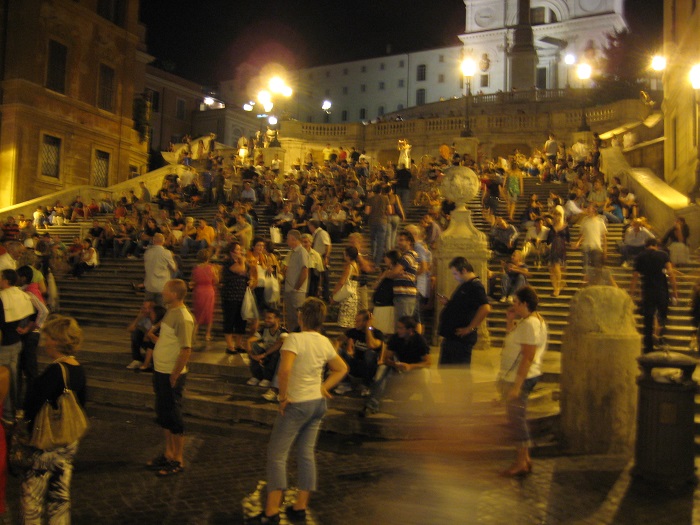
This is only the lowest flight of the broad series of steps that sweep out and back as they climb toward the church. This lower level opens onto the Piazza de Spagna. As you can see, the steps function mostly as gathering places. Everywhere crowds were out enjoying the night, including this bride and groom, joining the many couples choosing to be married on the steps:
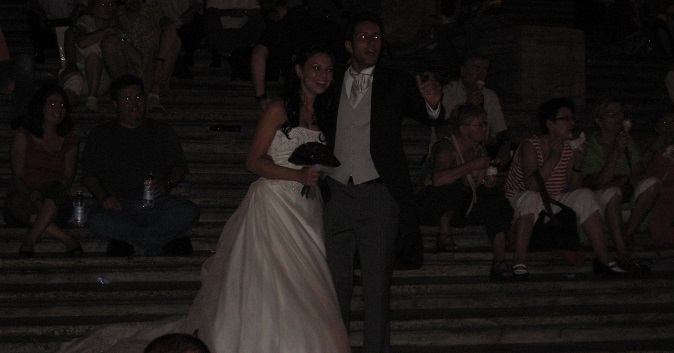
After a delicious al fresco dinner of calamari at one of many patio restaurants luring passersby, our first destination was the glorious Trevi Fountain. It was built in 1762 to a design by Nicola Salvi, who was inspired by ancient Roman triumphal arches like those we saw in last week’s blog post in the Forum.
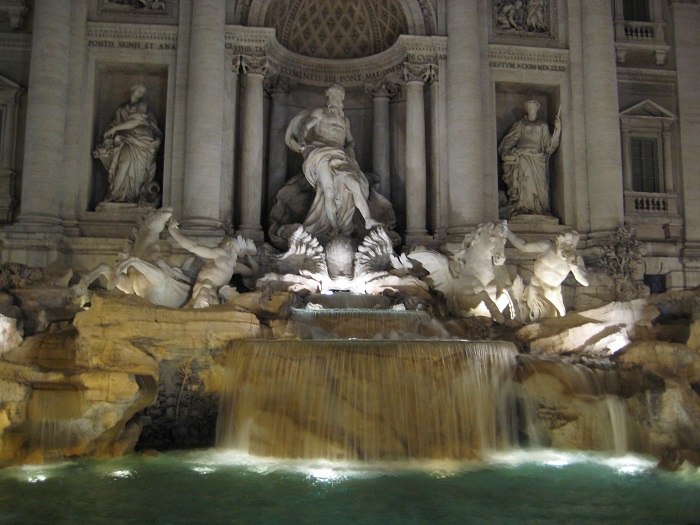
The central figure, Neptune god of the sea, sits above two Tritons with horses. The site was originally the start of the Aqua Virgo aqueduct built in 19 B.C. The figure of the young woman at Neptune’s right is apparently pointing at the source of the spring feeding the aqueduct.
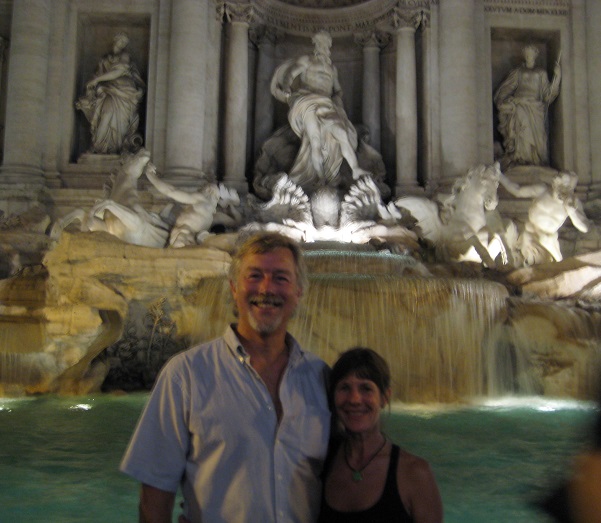
Thor and I threw coins in the fountain, of course, as tradition holds that we will then return some day. Thor had been there a few years earlier, so it worked for him. Actually, we returned during the daylight a couple days later!
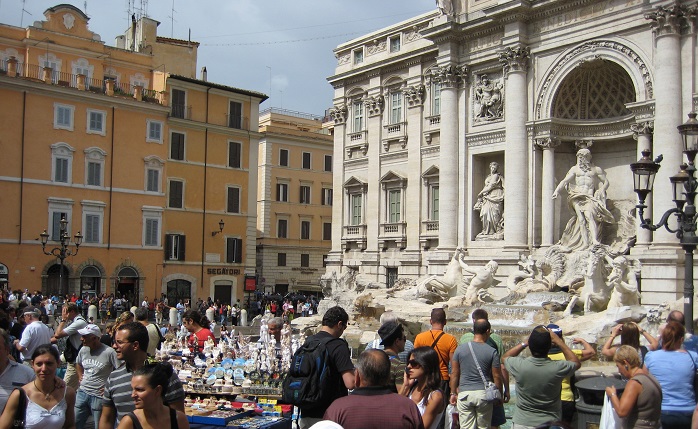
There was a very different vibe during the heat of the day, with even more crowds filling the piazza.
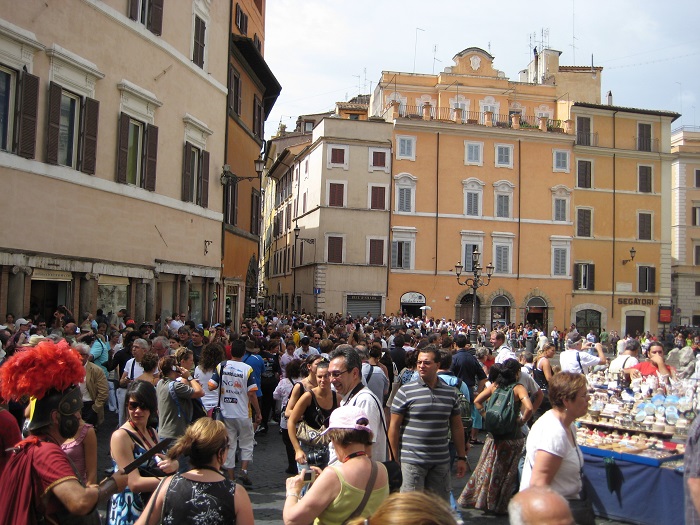
Looking back from our present Pandemic reality, it seems unbelievable that we could be part of such crowds. The guy at lower left in the Roman legion getup offered photo ops, but we turned him down.
The baking heat and the sight of all that unattainable water had us searching for another one of those life-saving “vapas” or spring-fed drinking fountains helpfully abundant in the city. Note that the second person in the photo below was dunking his head, as Thor had done during his almost-heat-stroke in the Forum (last week’s post).
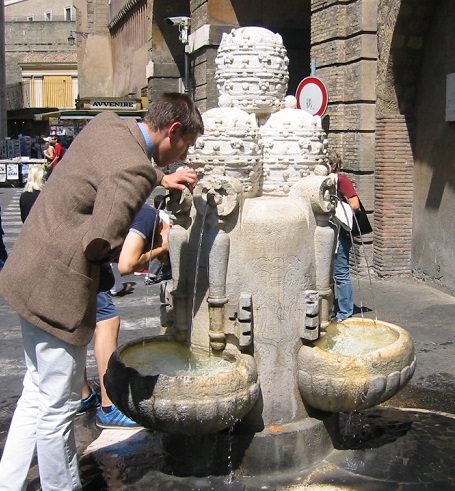
On to another fountain, Fontana del Tritone in the Piazza Barberini. The sculptor Gian Lorenzo Bernini created it in 1642 for Pope Urban VIII Barberini, the first of three fountains the pope commissioned to supply water from the aqueduct to the public. It features Triton, son of the Greek sea-god Poseidon (renamed Neptune by the Romans), holding up a conch shell that spouts water. The mer-man deity with fishy legs perches on a scallop shell supported by Greek-style dolphins.
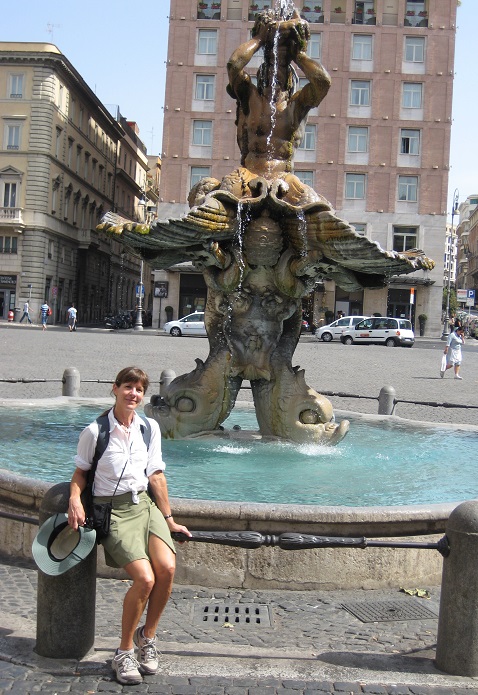
The last fountain on this ramble is La Fontana Delle Naiadi — fountain of the Naiads — in the Piazza Della Repubblica. Originally called Piazza Esedra, the plaza was fronted by the semicircular “exedra” that was part of the Roman Baths of Diocletian. The ruins of the ancient baths were ordered by Pope Pius IV in 1561 to be remodeled into the Basilica Santa Maria degli Angeli e dei Martiri (St. Mary of the Angels and the Martyrs). Michelangelo received the commission and designed the beautiful basilica that incorporated surviving Roman elements such as the massive red granite pillars.
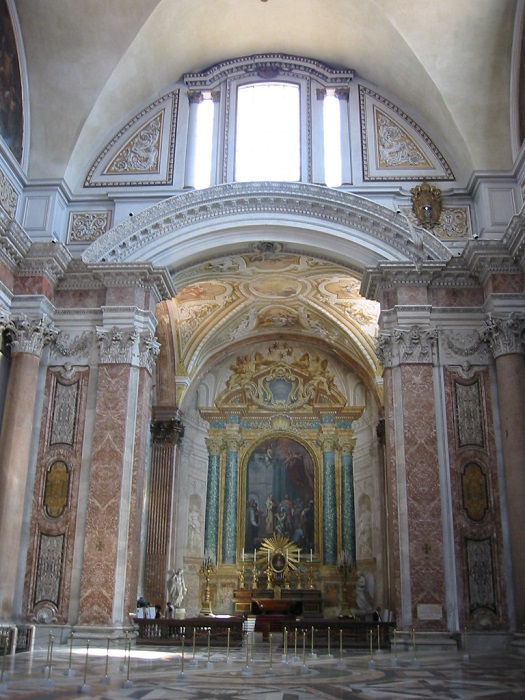
The fountain opposite the basilica entrance presents an ironic contrast to the Christian presence. Completed in 1912 to decorate an existing water basin, La Fontana Delle Naiadi shocked many Roman citizens with its celebration of pagan heritage in the form of four naked bronze naiads (Greek fresh-water deities). Protests arose, perhaps partly because the sculptor Mario Rutelli had modeled the naiads after two of his favorite prostitutes. Nevertheless, the fountain remained, with its four naiads at the four directions around the basin.
The first figure, The Naiad of the Rivers, lounges with a water snake in front of the basilica entrance, the former Roman bath’s exedra:
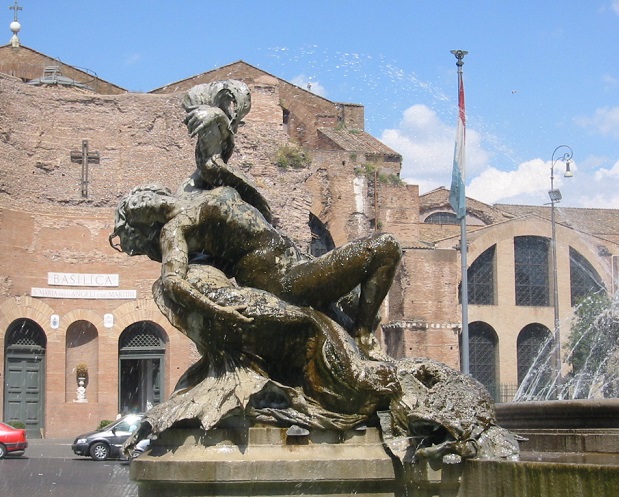
Next is the Naiad of the Oceans with a sea horse. (Actually, the nymphs of seas and oceans were called nereids by the Greeks, but apparently the sculptor took creative license).
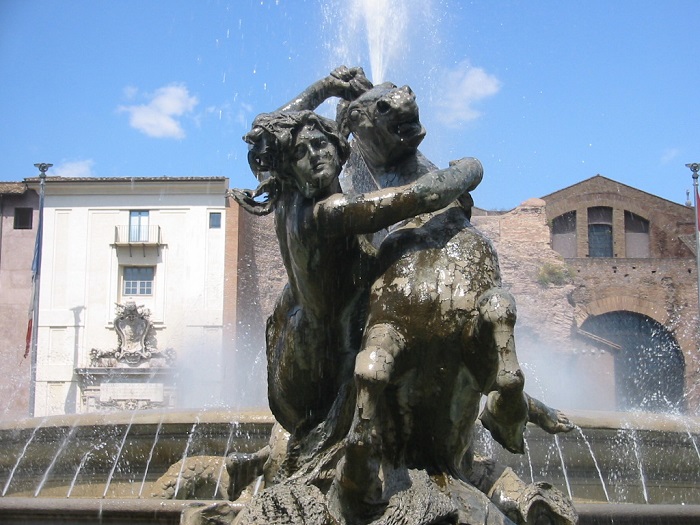
Next, the Naiad of the Lakes with a swan (echoes of Leda and the Swan, anyone?):
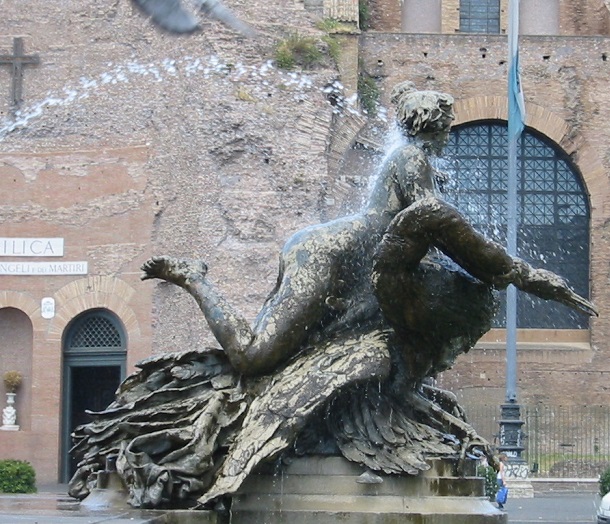
Finally, the Naiad of Underground Waters, with a strange lizardlike creature:
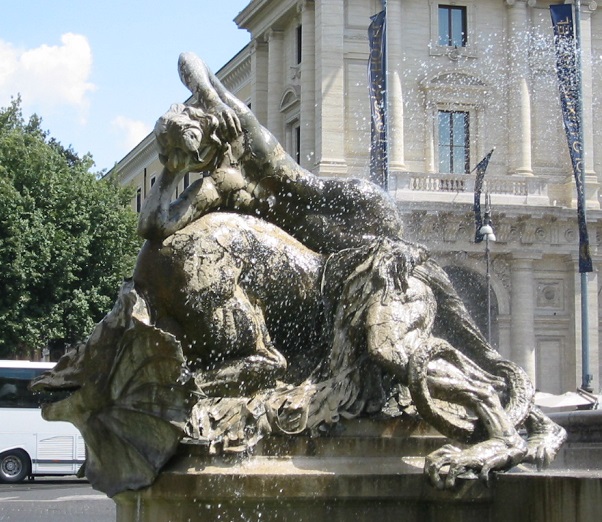
Thor took the photos above (I seem to have lost some of mine), and clearly he was more interested in the naiads than the large central figure surmounting the basin, a muscular man wrestling a dolphin. Thor shrugged off the historic protest against the figures, pointing out the presence of nude statuary everywhere in Italy. Though at the Vatican visit in an upcoming blog post, you might spot a plaster fig leaf or two placed over ancient nudes….
*****
You will find The Rambling Writer’s blog posts here every Saturday. Sara’s latest novel from Book View Cafe is available in print and ebook: The Ariadne Connection. It’s a near-future thriller set in the Greek islands. “Technology triggers a deadly new plague. Can a healer find the cure?” The novel has received the Chanticleer Global Thriller Grand Prize and the Cygnus Award for Speculative Fiction. Sara has recently returned from another research trip in Greece and is back at work on the sequel, The Ariadne Disconnect. Sign up for her quarterly email newsletter at www.sarastamey.com

Interesting blog, it reminds me of Fontana di Trevi in Rome. The theme “Taming of the Waters” is presented in grandiose baroque style
I tried to write a blog about it, hope you also like it https://stenote.blogspot.com/2021/10/rome-at-fontana-di-trevi.html
Thanks, Steve, for fascinating new insights into the fountains and “divinity of water.”